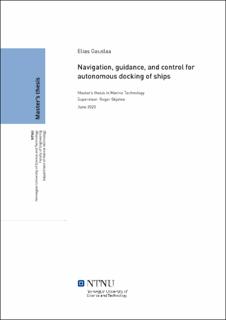| dc.contributor.advisor | Skjetne, Roger | |
| dc.contributor.advisor | Ren, Zhengru | |
| dc.contributor.advisor | Marley, Mathias | |
| dc.contributor.advisor | Ueland, Einar | |
| dc.contributor.author | Gauslaa, Elias | |
| dc.date.accessioned | 2021-09-21T16:27:53Z | |
| dc.date.available | 2021-09-21T16:27:53Z | |
| dc.date.issued | 2020 | |
| dc.identifier | no.ntnu:inspera:54166542:20895585 | |
| dc.identifier.uri | https://hdl.handle.net/11250/2780099 | |
| dc.description.abstract | Denne oppgaven presenterer en autonom dokkingkontroller som bruker tradisjonelle sensorer, med hjelp av nærhetssensorer. Dokkingkontrolleren er i stand til å legge et marint overflatefartøy til kai autonomt på en sikker og kontrollert måte, og enkel situasjonsbevissthet og reaktivitet blir implementert.
Utvikling av den autonome dokkingkontrolleren er delt inn i tre hovedkomponenter, \newline navigasjons-, gaidings- og kontrollsystemet. Gaidingssystemet består av en baneplanlegger som bestemmer hvor man skal plassere veipunktene for operasjonen, og en banegenerator som genererer en bane for fartøyet å følge, ved å bruke hybrid baneparametrisering for å kontinuerlig koble sammen veipunktene. Navigasjonssystemet benytter en ikke-lineær passiv estimator til å filtrere målinger og for å generere signaler for umålte tilstander brukt av kontrollsystemet. En dekoblet kaskadert tilbakestegskontroller brukes i kontrollsystemet for å manøvrere fartøyet i henhold til ønsket bane og orientering.
Den autonome dokkingoperasjonen kan deles inn i to faser. Den første består i å navigere fartøyet til et punkt utenfor det angitte kaiplassen, mens den andre fasen består i å bevege fartøyet sakte mot kaien og stoppe en ønsket avstand fra kaikanten. De valgte gaidingslovene genererer en dokkingbane, og manipulerer fartøyets fart under operasjonen slik at det stanser på slutten av hver fase. Nærhetssensorene brukes til å gi en retningskorreksjon for ønsket kurs når skipet ankommer slutten av den første fasen, samt manipulere hastigheten i den andre fasen basert på avstanden til kai. Løsninger for å muliggjøre situasjonsbevissthet basert på målingene fra nærhetssensorene blir utforsket, samt to reaksjoner på eventuelt oppdaget fare.
Både normal drift med forskjellige utgangsposisjoner med hensyn til kaien, og testing av situasjonsbevissthet og reaktivitet testes i simuleringer. For simuleringene ble C/S Enterprise modellert, og verdier funnet i eksperimenter ble brukt til aktuatormodellering. Simuleringene viser god ytelse av den autonome dokkingkontrolleren. | |
| dc.description.abstract | This thesis presents an autonomous docking controller utilizing a traditional sensor suite aided by proximity sensors. The docking controller is able to autonomously dock a marine surface vessel in a safe and controlled manner, and some basic situational awareness and reactiveness are implemented.
Development of the autonomous docking controller is divided into three main components, the navigation, guidance, and control systems. The guidance system consists of a path planner which decides where to place the waypoints of the operation, and a path generator which generates a trajectory for the vessel to follow using a hybrid path parametrization to smoothly and continuously concatenate the waypoints. The navigation system employs a nonlinear passive observer to filter measurements and to generate signals for unmeasured states, needed in the control system. An uncoupled cascaded backstepping controller is used in the control system to maneuver the vessel according to the desired trajectory and desired heading.
The autonomous docking operation is divided into two phases. The first one consists of navigating the vessel to a point outside the designated docking location, while the second phase consists of moving the vessel slowly towards the dock and stopping a desired distance from the quayside. The chosen guidance laws generate a docking path, and manipulate the speed of the vessel during the operation, making it come to rest at the end of each phase. The proximity sensors are used to provide a heading correction for the desired heading when the ship arrives at the end of the first phase, as well as manipulating the speed assignment during the second phase based on the distance to the quay. Solutions to enable situational awareness based on the proximity sensors measurements are explored, as well as two reactions to an eventual detected danger.
Both normal operation with different initial positions with respect to the dock, and operations testing the situational awareness and reactiveness are tested in simulations. For simulations, the C/S Enterprise was modeled, and values found in experiments was used for the thruster modeling. The simulations show good performance of the autonomous docking controller. | |
| dc.language | | |
| dc.publisher | NTNU | |
| dc.title | Navigation, guidance, and control for autonomous docking of ships | |
| dc.type | Master thesis | |
